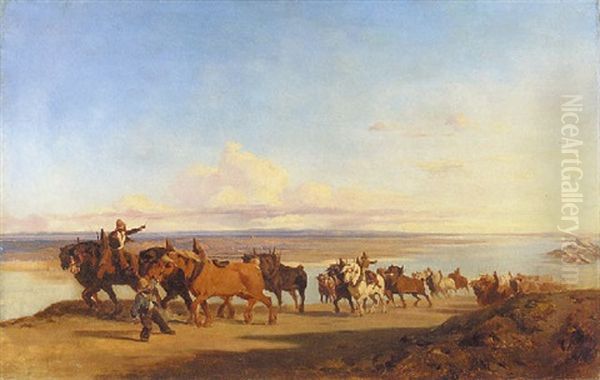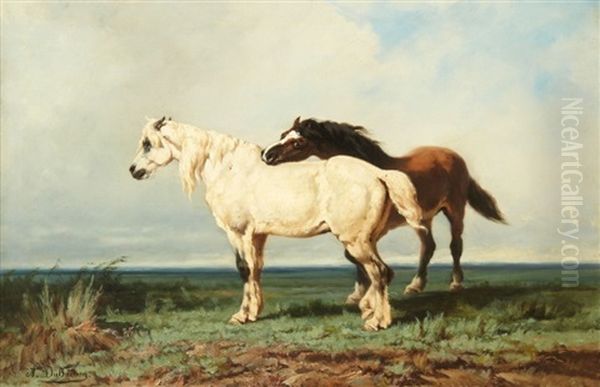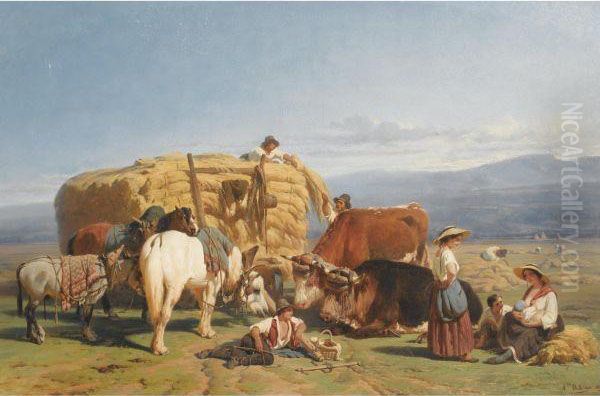Alexandre Dubuisson, a French painter active throughout the mid-19th century, carved a niche for himself by depicting the serene and often laborious scenes of pastoral life. Born in an era of significant artistic transition, Dubuisson's work offers a valuable window into the prevailing tastes and themes that captivated audiences before the full ascendance of Impressionism, while also reflecting the enduring appeal of the French countryside. His canvases, though perhaps not as widely known today as some of his more revolutionary contemporaries, contribute to our understanding of the artistic landscape of his time, particularly the enduring strength of Realist and Romantic traditions in genre painting.
Early Life and Artistic Formation
Jean Marie Alexandre Dubuisson was born in Lyon, France, in 1805. Lyon, a city with its own rich artistic and cultural heritage, would have provided an initial environment steeped in creative traditions. However, like many aspiring artists of his generation, Dubuisson eventually made his way to Paris, the undisputed epicenter of the art world in 19th-century Europe. It was in Paris that he sought formal artistic training, a crucial step for any painter aiming for recognition and success.
Dubuisson enrolled in the prestigious École des Beaux-Arts, the leading art institution in France. The curriculum at the École was rigorous, emphasizing classical principles, drawing from life and antique sculpture, and a thorough grounding in art history. During his studies, he is noted to have been a pupil of several influential figures. Sources mention him studying under Malbeste, and also Antoine-Jean Gros (1771-1835), a prominent painter known for his historical subjects and portraits, particularly those glorifying Napoleon. Gros himself was a student of Jacques-Louis David, linking Dubuisson to a strong Neoclassical lineage, though Gros's later work also showed Romantic tendencies. Some accounts also suggest he was a student of Louis Hersent (1777-1860), another respected academic painter known for historical scenes and portraits, who also taught at the École des Beaux-Arts. This academic training would have instilled in Dubuisson a strong foundation in draughtsmanship, composition, and the traditional techniques of oil painting.
Artistic Style and Thematic Focus

Alexandre Dubuisson's oeuvre is primarily characterized by its dedication to rural and pastoral themes. He excelled in capturing the everyday life of the French countryside, from the toil of agricultural labor to the tranquil moments of bucolic existence. His style can be seen as a blend of Realism, with its emphasis on truthful depiction of ordinary subjects, and a lingering Romantic sensibility, evident in the often idyllic or picturesque portrayal of nature and rural life.
Unlike the more politically charged Realism of Gustave Courbet, Dubuisson’s approach seems to have been less about social commentary and more focused on the aesthetic and narrative qualities of his chosen scenes. His paintings often feature peasants, farm animals, and expansive landscapes, rendered with a careful attention to detail and a desire to convey the atmosphere of the scenes. He demonstrated proficiency in various mediums, including oil on canvas, which formed the bulk of his significant works, but also utilized drawing, watercolor, and chalk, showcasing a versatile artistic skill set. His academic training is evident in the structured compositions and competent rendering of figures and environments.
Major Representative Works
Several key works define Alexandre Dubuisson's contribution to 19th-century French art, each illustrating his characteristic themes and stylistic approaches.
La Moisson (The Harvest)
Perhaps his most frequently cited work is La Moisson, an oil painting completed in 1850. This piece epitomizes Dubuisson's focus on rural labor. Harvest scenes were a popular subject in 19th-century art, symbolizing abundance, the cycle of nature, and the dignity of agricultural work. Dubuisson’s rendition would have aimed for a vivid and lifelike portrayal of harvesters in the field, likely emphasizing the communal effort and the golden light of late summer. The painting is noted for its realistic depiction of this quintessential pastoral activity. Interestingly, this painting gained renewed attention in the 21st century when it was featured in the "No Longer Art" exhibition by the Salvage Art Institute (SAI) in 2012, after having been discovered in a damaged state, highlighting ongoing efforts in art conservation and the re-evaluation of historical artworks.
Pferdepost (Mail Coach / Horse Post)

Dated to 1843, Pferdepost is another significant work by Dubuisson. Currently housed in the Musée des Beaux-Arts in Strasbourg, this painting likely depicts a mail coach drawn by horses, a common sight and vital mode of communication and transport in the pre-railway era. Such a scene would offer opportunities to portray animal movement, human interaction, and the landscape through which the coach travels. It speaks to the themes of travel, communication, and the pace of life in the mid-19th century. The choice of subject reflects an interest in contemporary life, albeit within a rural or transitional setting.
Le halage sur le Rhône (Towing on the Rhône)
This work, with versions or related pieces noted in the collections of the Bibliothèque nationale de France (B.N.F.) and the Musée des Beaux-Arts in Orléans (specifically Lyon B01CP690000116), depicts the arduous task of towing boats along the Rhône river. River scenes, particularly those involving labor, were common, allowing artists to explore the relationship between humans and the powerful forces of nature, as well as the economic lifeblood that rivers represented. This subject would have allowed Dubuisson to showcase his skills in depicting human figures in exertion, the rendering of water, and the specific landscape of the Rhône valley.
Deux chevaux (Two Horses)
Created between 1860 and 1870, Deux chevaux is an oil painting measuring 50 x 76 cm and is part of the collection at the Palais de Compiègne. As the title suggests, the work focuses on two horses, a subject that aligns perfectly with Dubuisson's interest in rural life and animals. Horses were integral to 19th-century agriculture, transportation, and daily life. This painting would have allowed Dubuisson to demonstrate his ability in animal portraiture, capturing their form, musculature, and perhaps their character. The later date of this work indicates his continued dedication to these themes throughout his career.
ESCENAS DE CAMPO (Country Scenes)
This title refers to a pair of oil paintings, each measuring 27.5 x 39 cm, created in 1856. As "Country Scenes," these works would further exemplify Dubuisson's commitment to depicting various facets of rural existence. The smaller scale might suggest more intimate or focused compositions, perhaps studies of specific activities, landscapes, or moments in the countryside. The creation of works in pairs was also a common practice, sometimes allowing for contrasting or complementary themes.
These representative works collectively paint a picture of an artist deeply engaged with the French countryside, its inhabitants, and their way of life. Dubuisson’s paintings serve as valuable visual documents of a world that was steadily transforming with the onset of industrialization.
The Artistic Milieu of 19th-Century France

Alexandre Dubuisson practiced his art during a dynamic and transformative period in French art history. The 19th century witnessed a succession of artistic movements, from the lingering dominance of Neoclassicism and the rise of Romanticism in its early decades, to the emergence of Realism in the mid-century, and finally, the revolutionary stirrings of Impressionism towards the latter part of his life.
Paris was the undisputed capital of this art world. The official Salon, organized by the Académie des Beaux-Arts, was the primary venue for artists to exhibit their work and gain recognition. Success at the Salon could lead to commissions, sales, and critical acclaim. Dubuisson, with his academic training, would have likely participated in these Salons. The Salon system, while prestigious, was also criticized for its conservative tendencies, often favoring historical, mythological, and religious subjects executed in a polished, academic style.
However, the mid-19th century also saw a growing interest in Realism, championed by artists like Gustave Courbet (1819-1877), who famously declared a commitment to painting only what he could see. Courbet's unidealized depictions of peasants and ordinary life challenged academic conventions. While Dubuisson’s work shared Realism's focus on everyday subjects, his style was generally less confrontational and perhaps more aligned with the picturesque tradition.
The Barbizon School, active from the 1830s to the 1870s, also played a significant role in popularizing landscape and rural scenes. Painters like Jean-Baptiste-Camille Corot (1796-1875), Jean-François Millet (1814-1875), and Théodore Rousseau (1812-1867) focused on direct observation of nature and sympathetic portrayals of peasant life, often imbuing their work with a poetic or spiritual quality. Dubuisson's thematic concerns resonate with those of the Barbizon painters, although his stylistic approach might have retained more academic polish.
By the 1860s and 1870s, Impressionism began to emerge, with artists like Claude Monet (1840-1926), Pierre-Auguste Renoir (1841-1919), and Edgar Degas (1834-1917) prioritizing the fleeting effects of light and color, often painting en plein air. While Dubuisson was a contemporary of these early Impressionists, his artistic path remained rooted in more established traditions of representation. The period around 1875, the year of Dubuisson's death, was particularly vibrant. Paris hosted significant art exhibitions that attracted international attention, showcasing a diverse range of artistic styles and fostering cross-cultural exchange. The first Impressionist exhibition had taken place in 1874, signaling a major shift in the art world.
Contemporaries and Connections
While specific records detailing Alexandre Dubuisson's direct interactions or collaborations with other prominent painters are not extensively documented in the provided information, he was undoubtedly part of a bustling artistic community. His active period, spanning roughly from the 1830s to his death, placed him amidst a constellation of talented individuals.
Among the many painters active during Dubuisson's lifetime, several stand out for their contributions to various genres:
Eugène Delacroix (1798-1863), a leading figure of French Romanticism, known for his dramatic historical and orientalist scenes.
Honoré Daumier (1808-1879), a prolific caricaturist, painter, and sculptor, celebrated for his sharp social and political commentary.
Rosa Bonheur (1822-1899), a highly successful animal painter and sculptor, renowned for works like The Horse Fair. Her focus on animals would have shared some thematic ground with Dubuisson.
William-Adolphe Bouguereau (1825-1905), a quintessential academic painter, immensely popular for his idealized mythological and genre scenes.
James Tissot (1836-1902), known for his elegant depictions of fashionable society in Paris and London.
Berthe Morisot (1841-1895), one of the leading female Impressionist painters, known for her intimate portrayals of domestic life.
The Italian painter Giuseppe De Nittis (1846-1884) was active in Paris during this period, becoming friends with Degas and capturing modern Parisian life.
The provided information also lists several other French painters active contemporaneously with Dubuisson, reflecting the sheer number of artists working at the time. These include:
François-Jacques Destape
Edouard Detaille (1848-1912), a student of Meissonier, famous for his precise and detailed military scenes.
Laurent-Didier Dettonville
Louis Devodé
Eugène Devéria (1805-1865), a Romantic painter known for historical subjects, a direct contemporary by birth year.
Mathilde Duckett
Jean-Louis Dunod
Leon Dupray
Pierre Dupuis (care should be taken as there was an earlier still-life painter of the same name; a 19th-century figure is implied here)
Charles-Auguste Durand (Carolus-Duran, 1837-1917), a fashionable portraitist and teacher.
Henri Durand-Brager (1814-1879), a marine painter.
Jacques Léon Durand
Leon Dussardier
Charles-Allene Duval
Antoine-Jules Duval
While Dubuisson may not have been part of a specific, named artistic group or movement in the way the Barbizon painters or Impressionists were, his participation in the Parisian art scene, likely through Salon exhibitions, would have placed him in dialogue, however indirect, with these varied artistic currents and figures.
Later Life, Death, and Legacy
Alexandre Dubuisson passed away in 1875. By this time, the art world was on the cusp of major changes, with Impressionism gaining momentum and challenging the established academic order. Dubuisson's career spanned a period that saw the height of Romanticism, the consolidation of Realism, and the birth of modern art.
His legacy lies in his consistent and skilled portrayal of French rural life. His works contribute to the rich tradition of genre painting in the 19th century, offering glimpses into a way of life that was increasingly being altered by industrialization and urbanization. While he may not have achieved the revolutionary fame of some of his contemporaries, his paintings hold historical and artistic value.
The continued interest in his work is evidenced by its presence in museum collections such as the Musée des Beaux-Arts in Strasbourg and Orléans, and the Palais de Compiègne. Furthermore, the inclusion of his painting La Moisson in the Salvage Art Institute's 2012 exhibition, "No Longer Art," underscores the ongoing relevance of his work in discussions about art conservation, value, and historical memory. Such instances ensure that artists like Dubuisson are not forgotten and that their contributions continue to be studied and appreciated.
Art Historical Evaluation
Art historians generally position Alexandre Dubuisson as a competent and dedicated painter of 19th-century French rural scenes. His work is appreciated for its technical skill, a product of his academic training at the École des Beaux-Arts, and for its sincere engagement with its subject matter. He is recognized for his ability to create vivid, realistic depictions of pastoral life, capturing both the labor and the tranquility of the countryside.
His paintings are valuable for several reasons:
1. Documentary Value: They provide visual records of 19th-century agricultural practices, rural customs, and landscapes.
2. Artistic Merit: His compositions are generally well-structured, his figures competently rendered, and his use of color and light effective in conveying mood and atmosphere.
3. Contextual Significance: His work helps to flesh out our understanding of the artistic currents of his time, particularly the enduring appeal of Realist and Romantic approaches to genre painting, which coexisted with and sometimes stood in contrast to the more avant-garde movements.
While not an innovator in the vein of Courbet or Monet, Dubuisson represents a significant stream of 19th-century art that found beauty and meaning in the ordinary and the traditional. His dedication to portraying the French countryside and its people ensures his place as a noteworthy, if perhaps understated, figure in the narrative of French art. His paintings offer a quiet counterpoint to the more dramatic artistic upheavals of his era, reminding us of the diverse artistic expressions that flourished during this rich period.
Conclusion
Alexandre Dubuisson remains a figure worthy of study for his earnest and skillful depictions of 19th-century French rural life. His paintings, such as La Moisson and Pferdepost, capture a world of pastoral labor and scenic beauty, reflecting both Realist attention to detail and a Romantic appreciation for the countryside. Educated within the academic tradition of the École des Beaux-Arts, he navigated an era of profound artistic change, contributing to the rich tapestry of French genre painting. While perhaps not a revolutionary, his work provides valuable insight into the themes and styles that resonated in his time, and his legacy continues through museum collections and the ongoing efforts of art conservation and historical study. Dubuisson's canvases offer a gentle, observant window onto a bygone era, securing his modest but meaningful place in the annals of art history.